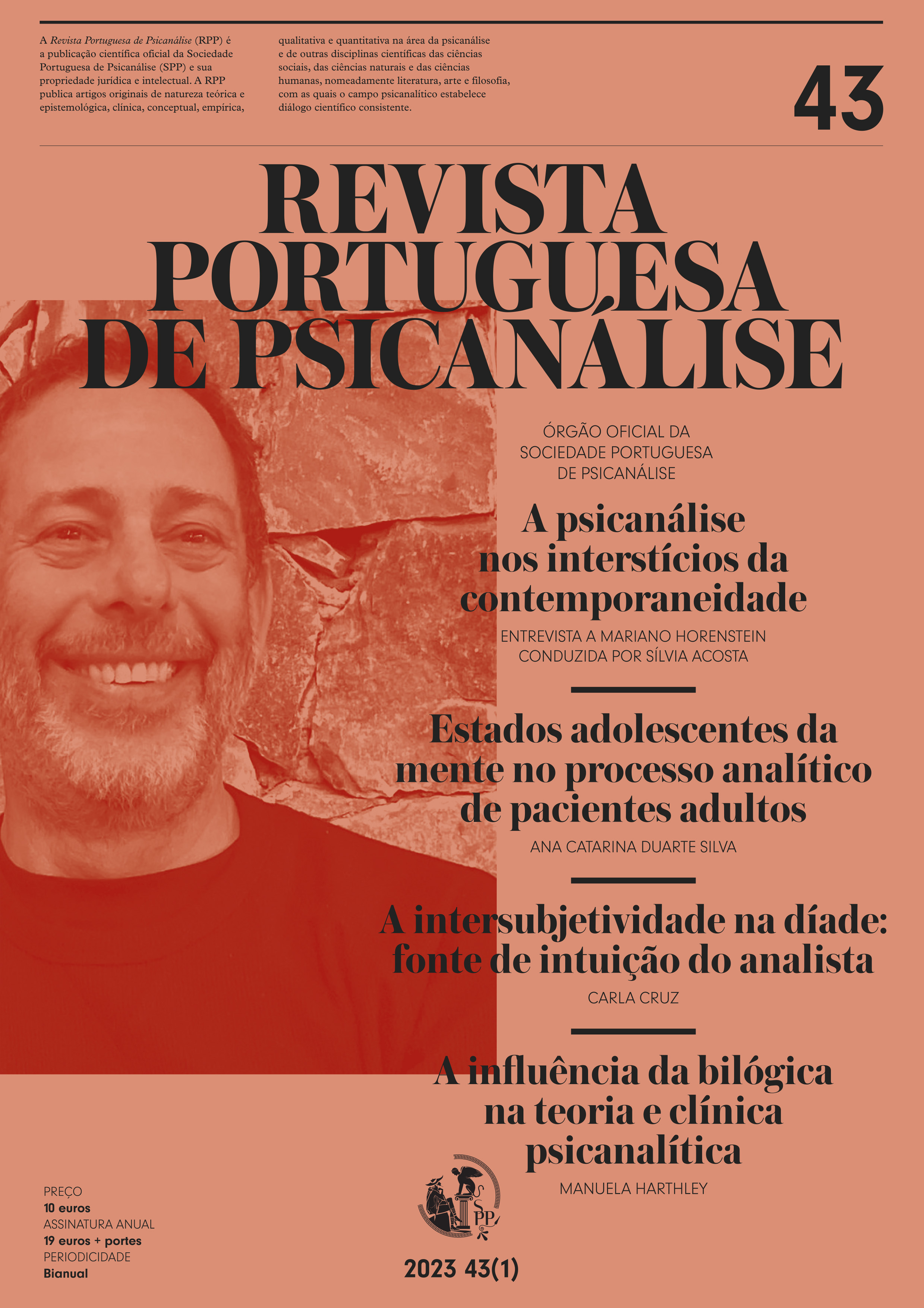Do amor (e do ódio) na contratransferência às violações dos limites sexuais na relação analítica

Resumo
O amor (como o ódio) contratransferencial é omnipresente na relação analítica, ainda que sob diferentes formas, e não apenas transmite informações cruciais sobre o paciente e sobre o próprio analista como é mesmo imprescindível para a criatividade do processo analítico. Mas seja qual for a forma de amor em causa, ela deve ser distinguida, sempre, da violação dos limites da relação analítica que constituirá qualquer contacto sexual entre analista e analisando, transgressões que estão presentes na prática psicanalítica desde os seus primórdios. Importa, por isso, esclarecer o que entendemos por amor contratransferencial e identificar as suas funções no processo psicanalítico, atentando não só ao seu papel terapêutico, mas também ao seu papel destrutivo. Assim, a partir de uma revisão bibliográfica sobre o tema e da inclusão de duas breves vinhetas clínicas, propomos uma reflexão em torno do amor contratransferencial e, posteriormente, de algumas das especificidades da teoria e da prática psicanalíticas — bem como do funcionamento institucional — que podem, de algum modo, contribuir para a manutenção das transgressões sexuais dos limites da relação terapêutica, finalizando com algumas propostas de debate sobre estratégias que visem a prevenção da ocorrência desse tipo de violações.
Palavras-chave
Psicanálise, Relação analítica, Ética, Violação dos limites sexuais
Biografia Autor
Orlando von Doellinger
Psicanalista, Médico Psiquiatra, Doutorado em Psicologia Clínica. Membro com funções didáticas da Sociedade Portuguesa de Psicanálise (SPP).
Referências
- Blechner, M. J. (2014). Dissociation among Psychoanalysts about Sexual Boundary Violations. Contemporary Psychoanalysis, 5(1–2), 23–33. https://doi.org/10.1080/00107530.2014.868299
- Celenza, A. (2021). Shadows that corrupt: Present absences in the psychoanalytic process. Em
- C. Levin (Ed.), Sexual boundary trouble in psychoanalysis – Clinical perspectives on Muriel Dimen’s concept of the “Primal Crime” (pp. 77–93). Routledge.
- Dimen, M. (2011). Lapsus Linguae, or a Slip of the Tongue?: A Sexual Violation in an Analytic Treatment and its Personal and Theoretical Aftermath. Contemporary Psychoanalysis, 47(1), 35–79. https://doi.org/10.1080/00107530.2011.10746441
- Dimen, M. (2016). Rotten Apples and Ambivalence: Sexual Boundary Violations through a Psychocultural Lens. Journal of the American Psychoanalytic Association, 64(2), 361–373. https://doi. org/10.1177/0003065116640816
- Elise, D. (2019). Creativity and the erotic dimensions of the analytic field. Routledge.
- Ferenczi, S. (1980). Final Contributions to the Problems and Methods of Psycho-Analysis. Maresfield Reprints. (Original publicado em 1933.)
- Freud, S. (1966). Observac?o?es sobre o amor transferencial (Novas recomendac?o?es sobre a te?cnica de psicana?lise III). Edic?a?o Standard Brasileira das Obras Completas de Sigmund Freud (vol. xii, pp. 177–188). Imago. (Original publicado em 1915.)
- Frosch, J. P. (2021). The analyst’s narcissism and the denial of limits. Em C. Levin (Ed.), Sexual boundary trouble in psychoanalysis – Clinical perspectives on Muriel Dimen’s concept of the “Primal Crime” (pp. 105–116). Routledge.
- Gabbard, G. O. (1991). Psychodynamics of Aexual Boundary Violations. Psychiatric Annals, 21(11), 651–655. https://doi.org/10.3928/0048-5713- 19911101-06
- Gabbard, G. O. (1994). Sexual Excitement and Countertransference Love in the Analyst. Journal of the American Psychoanalytic Association, 42(4), 1083–1106. https://doi.org/10.1177/000306519404200408
- Gabbard, G. O. (1996). Lessons to be Learned from the Study of Sexual Boundary Violations. American Journal of Psychotherapy, 50(3), 311–322. https://doi. org/10.3109/00048679709073839
- Gabbard, G. O. (1999). Boundary Violations and the Psychoanalytic Training System. Journal of Applied Psychoanalytic Studies, 1, 207–221. https://doi.org/10.1023/A:1023200230822
- Gabbard, G. O. (2002). Post-termination sexual boundary violations. Psychiatric Clinics of North America, 25, A593–A603. http://dx.doi. org/10.1016/S0193-953X(02)00006-0
- Gabbard, G. O. (2017). Sexual boundary violations in psychoanalysis: A 30-year retrospective. Psychoanalytic Psychology, 34(2), 151–156. http:// dx.doi.org/10.1037/pap0000079
- Gabbard, G. O., & Lester, E. P. (1995). Boundaries and boundary violations in psychoanalysis. Basic Books.
- Guralnik, O. (2021). Sex and ethics: protecting an enchanted space. Em C. Levin (Ed.), Sexual boundary trouble in psychoanalysis – Clinical perspectives on Muriel Dimen’s concept of the “Primal Crime” (pp. 94–104). Routledge.
- Levin, C. (2021). Introduction – From “Eew” to we: an overview of Muriel Dimen ?s contribution to psychoanalytic ethics. Em C. Levin (Ed.), Sexual boundary trouble in psychoanalysis – Clinical perspectives on Muriel Dimen’s concept of the “Primal Crime” (pp. 1–21). Routledge.
- Levine, H. B. (2010). Sexual boundary violations: A psychoanalytic approach. British Journal of Psychotherapy, 26(1), 50–63. https://doi.org/10.1111/j.1752-0118.2009.01155.x
- Nacht, S. (1962).The curative factors in psychoanalysis. International Journal of Psychoanalysis, 43, 206–211.
- Pinsky, E. (2011). The Olympian Delusion. Journal of the American Psychoanalytic Association, 59(2), 351–376. https://doi. org/10.1177/0003065111406274
- Rabin, H. M. 2003. Love in the Coutertransference – Controversies and Questions. Psychoanalytic Psychology, 20(4), 677–690. https://doi. org/10.1037/0736-9735.20.4.677
- Saketopoulou, A. (2020). The Infantile Erotic Countertransference:The Analyst’s Infantile Sexual, Ethics, and the Role of the Psychoanalytic Collective. Psychoanalytic Inquiry, 40(8), 659–677. https://doi.org/10.1080/073516 90.2020.1826280
- Saketopoulou, A. (2017). Muriel Dimen: Teacher, Mentor, Psychoanalytic Scholar. Studies in Gender and Sexuality, 18(2), 143–48. http:// dx.doi.org/10.1080/15240657.2017.1312885
- Sherby, L. B. (2009). Considerations on Countertransference Love. Contemporary Psychoanalysis, 45(1), 65–81. https://doi.org/10.1 080/00107530.2009.10745987
- Slochower, J. (2017). Don’t tell anyone. Psychoanalytic Psychology, 34(2), 195–200. https://doi.org/10.1037/pap0000082
- Tubert-Oklander, J. (2021). Do we really need boundaries?. Em C. Levin (Ed.), Sexual boundary trouble in psychoanalysis – Clinical perspectives on Muriel Dimen’s concept of the “Primal Crime” (pp. 171–186). Routledge.
- Wrye, H. K., & Welles, J. K. (1994). The narration of desire: Erotic transferences and countertransferences. The Analytic Press.